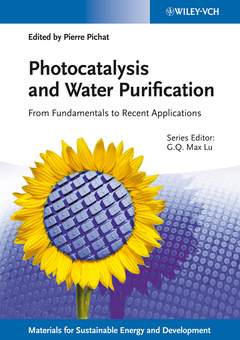Photocatalysis and Water Purification From Fundamentals to Recent Applications Materials for Sustainable Energy and Development Series
Coordonnateur : Pichat Pierre
Directeur de Collection : Lu Max

Photocatalysis comprises a class of reactions which use a catalyst activated by light. These reactions include the decomposition of organic compounds into environmental friendly water and carbon dioxide, leading to interesting properties of surfaces covered with a photocatalyst:
they protect e.g. against incrustation of fouling matter, they are self-cleaning, antibacterial and viricidal. Therefore, they are attractive candidates for environmental applications such as water purification and waste-water treatment.
This book introduces scientists and engineers to the fundamentals of photocatalysis and enlightens the potentials of photocatalysis to increase water quality. Also, strategies to improve the photocatalytic efficacy are pointed out: synthesis of better photocatalysts, combination of
photocatalysis with other technologies, and the proper design of photocatalytic reactors. Implementation of applications and a chapter on design approaches for photocatalytic reactors round off the book.
'Photocatalysis and Water Purification' is part of the series on Materials for Sustainable Energy and Development edited by Prof. G.Q. Max Lu. The series covers advances in materials science and innovation for renewable energy, clean use of fossil energy, and greenhouse gas mitigation and associated environmental technologies.
Identification and Roles of the Active Species Generated on Various Photocatalysts
Photocatalytic Reaction Pathways -
Effects of Molecular Structure, Catalyst, and Wavelength
Catalytic Mechanisms and Reaction Pathways Drawn from Kinetic and Probe Molecules
IMPROVING THE PHOTOCATALYTIC EFFICACY
Design and Development of Active Titania and Related Photocatalysts
Modified Photocatalysts
Immobilisation of a Semiconductor Photocatalyst on Solid Supports: Methods, Materials and Applications
Wastewater Treatment Using Highly Functional Immobilized TiO2 Thin Film Photocatalysts
Sensitization of Titania Semiconductors: A Promising Strategy to Utilize Visible Light
Photoelectrocatalysis for Water Purification
EFFECTS OF PHOTOCATALYSIS ON NATURAL ORGANIC MATTER AND BACTERIA
Photocatalysis of Natural organic Matter in Water: Characterization and Treatment Integration
Waterborne E. coli Inactivation by TiO2 Photo-Assisted Processes: A Brief Overview
MODELING. REACTORS. PILOT PLANTS
Photocatalytic Treatment of Water: Irradiance Influences
A Methodology for Modeling Slurry Photocatalytic Reactors for Degradation of an Organic Pollutant in Water
Design and Optimization of Photocatalytic Water Purification Reactors
Photocatalysis Soliar Pilot Plants. Commercially Available Reactors
At the "9th International Conference on TiO2 photocatalysis: fundamentals and applications", held in 2004 in San Diego, he received an Appreciation Award acknowledging his pioneering contributions; this award has been conferred to only three scientists in 20 years.
Date de parution : 04-2013
Ouvrage de 438 p.
17.7x24.9 cm
Thèmes de Photocatalysis and Water Purification :
Mots-clés :
Materials for Sustainable Energy and Development series, G, Q, Max Lu, photocatalysis, water quality, photocatalytic efficacy, photocatalytic reactors, energy-saving, green technologies, water purification, waste-water treatment, Pierre Pichat, heterogeneous photocatalysis, green technology, sustainable energy



